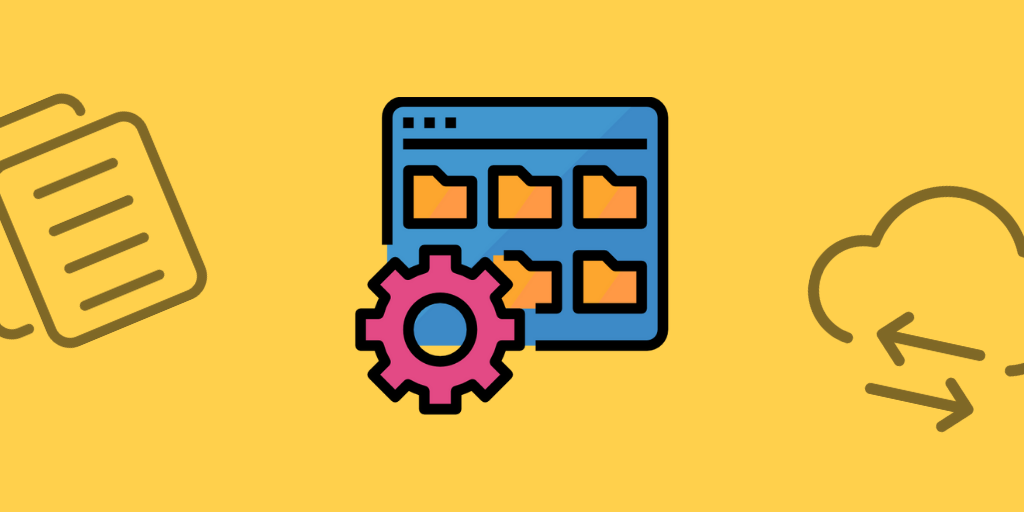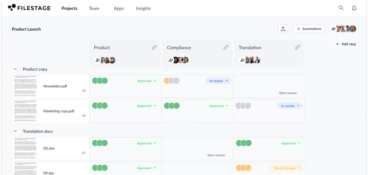Take a wild guess: How many document pages can you cram into 1 terabyte of storage?
According to Dropbox, you can save up to 6.5 million document pages in 1 TB, with files commonly stored as Office docs, PDFs, and presentations. In contrast, a vertical file drawer can only hold up to 5,000 pages, depending on its size.
A paperless office is great – but keeping your digital filing system organized can be a hassle. In the worst case, important documents may be lost or team members spend hours just searching for the proper files. Decentralized document management across multiple teams and offices comes with additional organizational needs.
Therefore, we are going to introduce you to document management systems and software that can help you and your company organize your digital storage.
What Is Document Management?
Document management is the process of storing, locating, updating, sharing and tracking documents. Documents can be defined as written material, whether printed or purely electronic, that contain information for several purposes.
What is the purpose of document management?
Once you have integrated an efficient document management workflow, you can be sure that documents will no longer disappear, even if they date back multiple years. Additionally, the search process will be reduced to minutes instead of hours, days or even weeks.
Just a few decades ago, the document management process was simple: Important documents were not saved inside a cloud, but inside a file drawer at the local office, which contained all important files in alphabetical order.
With today’s increased collaboration across functions and even organizations, there is no alternative to digitizing your documents – this is even true for small business document management.
However, it should be obvious that the larger the organization, the more guidelines and structures are needed to establish and maintain a system that ensures proper document management.
Therefore, enterprise document management almost exclusively involves a cloud-based document management solution that works efficiently across teams, offices and even country borders.
This is why Bayer, for example, decided to consolidate all of its brand assets into a single platform, so that team members all over the world have access to similar resources for a unified branding approach, which is especially important in the healthcare industry.

When people talk about document management today, in most cases they’re referring to a document management system (DMS), which is a computer system that can store, manage and track electronic documents for users.
In the next section, we will explore DMS in more detail.
What Is a Document Management System (DMS) and How Does It Work?
A document management system (DMS) is a computer system that helps a company structure and streamline its document workflow.
This involves the following processes:
Organizing your folder structure
No matter whether documents are printed or digital, DMS software can help you organize your folder structure. By using a simple and intuitive folder structure, all team members can easily store files as well as find documents uploaded by other team members.
Document uploading
Since most organizations not only use electronic files, but also digitize paper documents, a good document system should enable users to upload files through multiple methods, including (bulk) uploads, scanner, email or mobile applications.
Document indexing
If you do not index your files, the chances are high that some may never be found again, even after only a short period of time. Indexing describes the process of tagging documents with different search terms so that they can be easily tracked and located.
Document searching
The best indexing function is useless if your DMS software lacks a powerful search function. A search function should be simple and at the same time offer a wide range of customizable search options.
Workflow automation
A large organization with thousands of employees would lose an unimaginable amount of work hours if everything needed to be done manually. A document system with workflow automation allows users to establish rules regarding how new documents should be formatted and saved.
Document security
Security features should always be a priority, and they’re indispensable for some businesses. For instance, legal document management requires the highest security standards as documents contain personal information about clients and cases. Furthermore, good records management requires version control.
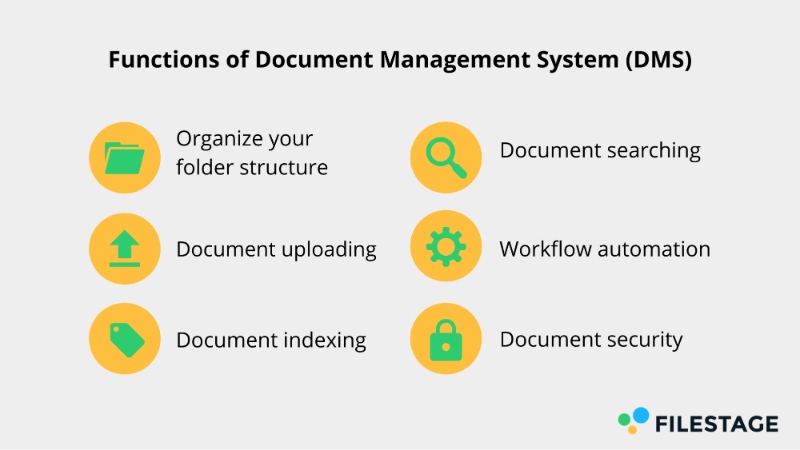
Document management software differs hugely according to the target market. Construction document management has different requirements than real estate document management; accordingly, document management tools cater to different audiences by introducing a range of different features.
Today’s best document management solutions are based in the cloud, as this gives businesses the capability to work across multiple locations without needing to set up complicated internal processes.
In the following section, we show you how much money, time and energy you can save with a well-functioning DMS.
What Is the Purpose of Document Management?
First of all, let’s clarify the importance of paperless document management software. By employing digital or online document management solutions, a company can save space, paper and labor as compared to paper-based solutions.
At first sight, this may seem trivial; however, research shows the real cost of paper: Companies spend an average of $20 to file just a single paper document (this includes the cost of labor, storage and other expenses). Additionally, workers in professional fields that use paper files spend 50% of their time looking for information.
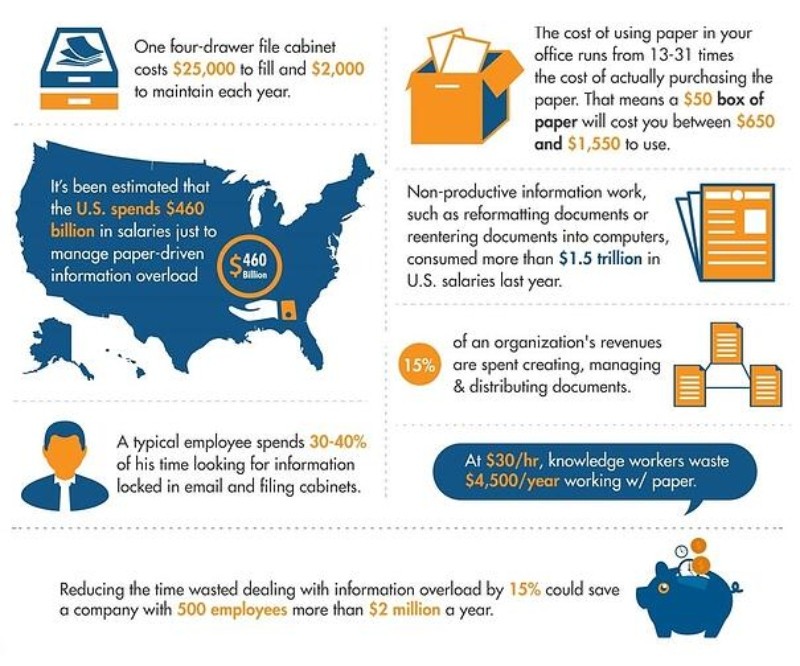
But this is just the tip of the iceberg.
Rather than simply analyzing how much money a company can save from discarding an inefficient paper-based system, it’s equally worthwhile to take a look at how much more efficient the company as a whole can become by employing a digital document management system.
What are the benefits of a thorough document management strategy?
By making use of a cloud-based document management tool, a company’s files can be accessed from anywhere at every time. The documents can be shared easily both inside and across teams as well as with external partners.
Through DMS, documents are traceable, which means team members spend less time recreating already existing assets. Document version control further adds a security layer to your cloud storage.
Overall process efficiency is improved through automation. Instead of manually filing each and every document, automation rules streamline the storage and indexing process.
Efficient document management can also improve the workflows of specific functions.
Every marketing manager realizes the growing importance of efficient marketing resource management, as workloads have increased over the years while deadlines and budgets have become tighter.
Through indexing, a company gains better control over all its assets, which contributes to the efficiency of brand asset management as well as the digital asset management strategy.
Furthermore, by having quick access to important documents such as marketing guidelines or policies, employees are much more likely to implement policies correctly. Therefore, DMS software contributes to increased consistency and a higher quality of assets throughout the entire organization.
To finish this section with an example:
Under Armour is one of the largest sports apparel brands in the world, employing more than 400 team members across five global locations. Without a well-functioning document management system in the form of a cloud-based DMS software, it would not be possible for Under Armour to efficiently share marketing assets or other collateral across all team members.
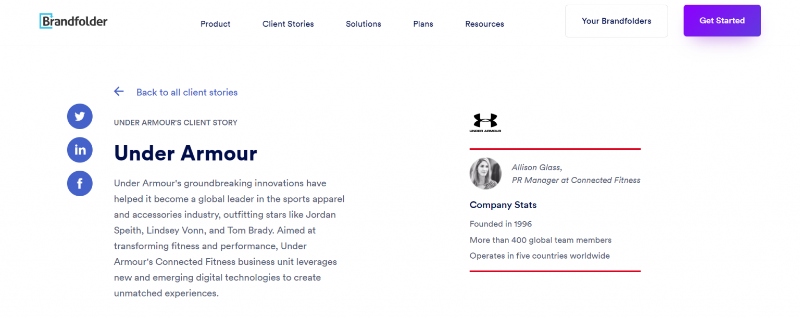
While this section outlined the purpose of document management, the next paragraph goes more into detail by outlining the most commonly used files and documents that almost every company utilizes.
What Are Common Use Cases for Document Management?
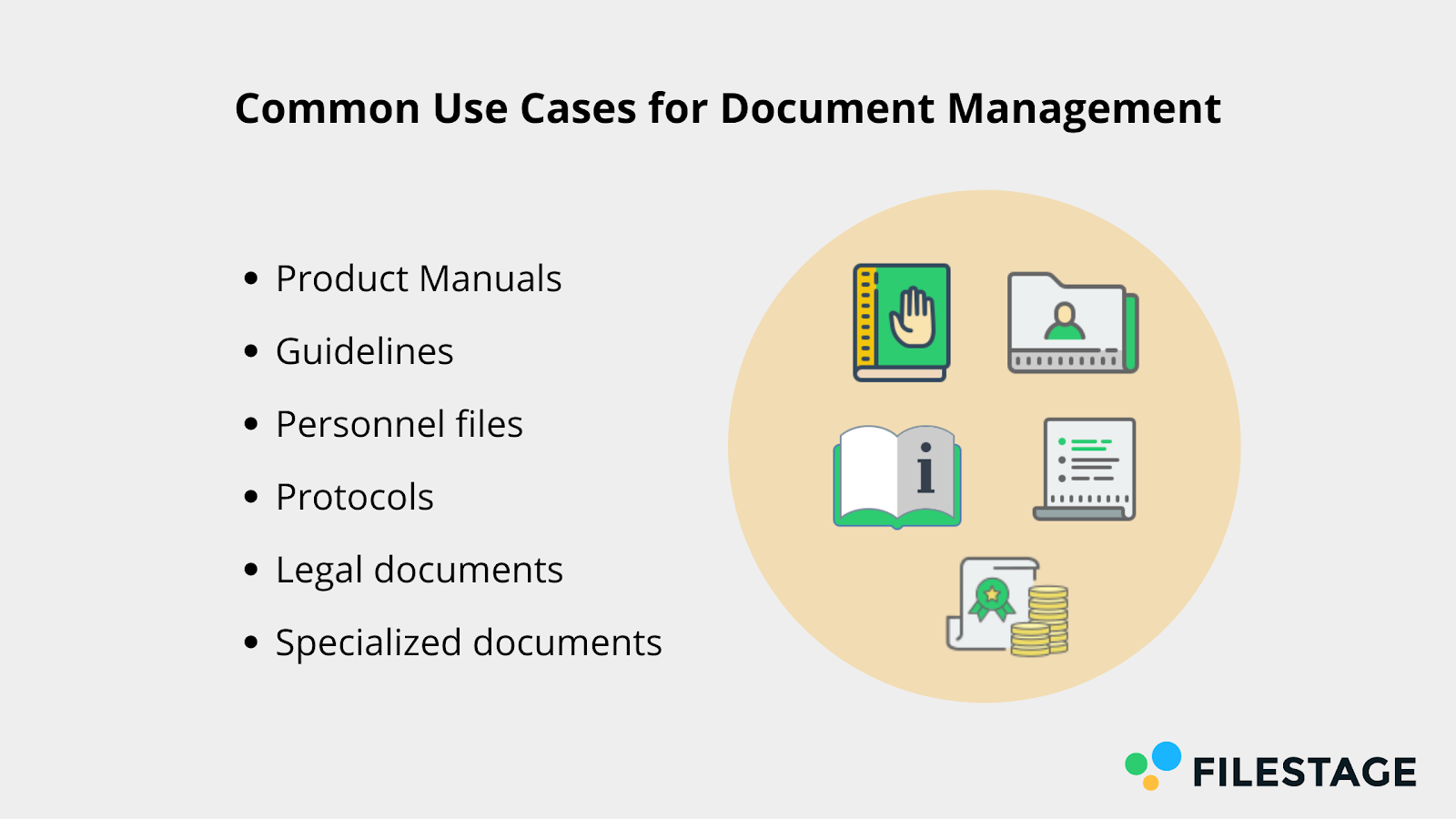
In this section, we give you the most common examples of documents that need to be managed by almost any organization.
Product Manuals
No matter if your company offers a product or a service, it’s likely that you also offer an accompanying manual. Product manuals come in all shape and forms. They may be for internal or external usage – for instance, they may target the company’s internal marketing or development teams or be geared towards customers who need to gain more information about the products.
Technical products especially need regularly updated guides. A thorough document management plan will help keep all manuals up-to-date with minimal effort.
Guidelines
Branding rules, compliance standards and design guidelines are an integral part of project management best practices. Establishing guidelines and finding a common denominator between all stakeholders are just the first steps.
It’s more difficult to constantly update guidelines and if necessary to re-establish a functioning workflow. Document collaboration tools help your team create guidelines and keep them up-to-date. The result is more brand, design and marketing compliance and more consistency throughout all assets.
Personnel files
Some documents need more security than others. Personnel files are confidential and should only be available to select upper management as well as certain members of the HR team.
A proper document management system implements access control so that confidential data can only be viewed by the right people. Even if you decide to opt for free document management software, make sure that no important features such as security standards are compromised.
Protocols
A protocol is a set of procedures or behaviors in an organization that accomplish a certain task. For instance, in marketing project management, you need to outline goals and objectives, as well as policies, protocols and procedures in order to achieve them.
A proper project documentation will keep your team structured. Document management systems will allow you to file, share and update protocols and to keep every shareholder up-to-date about the latest changes.
Legal documents
Legal documents need to be traceable. Sometimes, a contract has not been referred to for many years, but it still must be kept on file in case problems with the contracting party arise at a later date.
Legal documents are important files that must be safeguarded against accidental deletion. Therefore, a good DMS includes a file recovery system so that nothing unexpected can happen.
Specialized documents
Every industry uses specialized documents that require a slightly different approach. So, there is no general answer to the question “What is the best document management system?” Rather, it depends on the nature of your business and on the types of documents you use, such as construction documents, real estate documents, etc.
While some businesses need collaboration features included in their DMS, most businesses require reliable document approval software above all else.
In this section, we looked at the most commonly used types of documents. In the next section, we take a closer look at document management workflow.
What Does a Document Management Workflow Look Like?
Even if most documents are different and require individual workflows, there are some common ingredients in every approach that we outline in this section.

Depending on the task, make sure you’re not solely relying on DMS, but are also utilizing other useful file management software, such as project management tools and project management templates. That way, you are well-prepared from the get-go.
1. Creating the document
Once the goals, objectives, procedures, roles and responsibilities are determined, you can start with the creation of the document.
Depending on what kind of document you need to create, the creation process might involve cross-functional collaboration between copywriters and the design team.
Some document management systems employ collaboration tools or allow the integration of commonly used software, such as Google Docs.
2. Reviewing/ Approving the document
Once the first draft of the document is finished, the file can be uploaded to the DMS. It’s likely that you need approval from your superiors, other team members or even different functions before the document is finalized.
Without a proper document approval system, you must rely on lengthy email chains, numerous Skype groups or even running back and forth through the office. This is not only time-consuming and nerve-wracking, it leaves space for miscommunication and errors.
This is where Filestage comes into play. Filestage is a centralized, cloud-based file management software that facilitates the document review and approval process by offering a single platform to manage all your documents.
Documents can be easily shared, annotated and discussed between all involved stakeholders. All reviewers can request changes or approve the document with a single click. If changes need to be made, the content creator can revise the document and upload the new version again for another review step. Steps 1 and 2 might repeat themselves several times until the document receives final approval from all stakeholders involved.
This file management software makes it easy to organize and track the status of your documents as they receive a timestamped and documented approval.
3. Uploading the document to your DMS
After receiving final approval, you can upload the document to your DMS. Depending on what kind of document you are using, you may have already set up an automated process to save the document to the right location.
When uploading a document, make sure the file will be traceable by adding as many relevant tags as possible.
4. Publishing/ Sharing the document
You are now ready to share the document with all relevant stakeholders before you publish. Internal stakeholders will automatically be informed that a document is ready to review once you upload the file to the DMS.
External publications need further efforts. For instance, if your document is a piece of marketing collateral, such as an infographic, after the review you will need to publish your content on social media channels as predetermined in your project plan template.
As you can see from the workflow above, document management is rarely an end-goal but is usually a part of a broader marketing (or other) strategy.
Document management serves the purpose of streamlining all necessary documentation of the creation process.
In the next section, we elaborate more on the workflow step that is prone to the most difficulties – the review and approval process.
Diving Deeper into the Document Review and Approval Process
In this section we emphasize the importance of the review and approval process. If this key stage is neglected, many of the benefits that you expect from an efficient document management system will not materialize.
The review and approval process is the main source of bottlenecks – no matter if we are dealing with product manuals, internal protocols or other kinds of documents. If you can master the review and approval process, your team will be rewarded with a plethora of benefits, including:
Saving time
Usually, not just one but many stakeholders must approve a project – from marketers and product specialists to software developers and higher management, and these individuals are often based in different departments and at different locations.
If you have not outlined a clear structure for this process, instead of needing hours for an approval, you might need days, weeks and in the worst cases even months in order to collect all necessary feedback, reviews and final approvals.
With Filestage, a lot of the processes are automated: Once you upload the initial draft document, all stakeholders are automatically informed, eliminating the need for lengthy email chains.

All contributions, remarks and suggestions are noted on one platform, so that content creators can easily review all suggestions without the need to search through tons of email conversations.
Ensuring consistency and increasing quality
A centralized platform with clear responsibilities shared among the involved stakeholders automatically contributes to higher quality documents.
Each reviewer might focus on specific points, such as marketing compliance (are logos added?), wording, tone, spelling, latest product pictures, etc.
No matter your goals, a centralized review and approval system ensures that even small details will be implemented throughout all the assets you produce.
Getting a better overview about all work-in-progress documents
Since time is always a scarce resource, it’s important to be structured and have access to an overview of the status of current projects.
A good review and approval system may include project management capabilities that give you a bird’s eye view of all tasks.

For instance, at Filestage, with one look at the dashboard, you get a concise overview of all current tasks, including all timelines. If some tasks are overdue, you can take action and contact relevant team members through the collaboration features.
Efficient teamwork
Review and approval software such as Filestage also deliver collaboration tools that facilitate communication between all team members.
Instead of using separate messenger software and emails, the centralized platform has all these communication tools in one place and even allows you to directly upload your documents from Google Drive and Dropbox.
Clearly, without a careful review and approval stage, you can’t save time or achieve quality and consistency in your documents. Utilizing a DMS without planning the most crucial workflows is not enough.
Our next section outlines a few examples of best practices in creating an efficient document management workflow.
5 Document Management Best Practices to Create an Efficient Document Management Process
It should be clear by now that a document management process is not a one-size-fits-all solution, but that DMS is highly dependent on your industry, individual goals and objectives as well as your company’s structure.
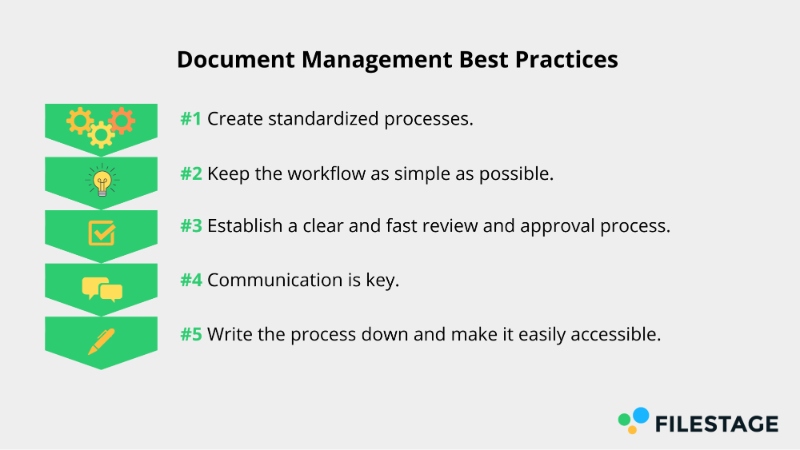
In the following section, we outline several best practices that can help establish the best document management workflow for your organization.
#1 Create standardized processes.
Always starting from scratch is not only nerve-wracking, it also takes up too many resources. Therefore, you need to create certain standards that all team members inside your organization can follow.
In the best case scenario, you can establish as many automation rules as possible so that your DMS takes most of the workload. Even if this is not always possible, everyone should be familiar with your file naming or indexing policies in order to create a consistent file structure.
#2 Keep the workflow as simple as possible.
There is no need to overcomplicate your workflow. Keep it as simple and memorable as possible so that everyone is willing to participate.
Too many complicated workflows can lead to frustration as co-workers may feel distracted from their main tasks. In the worst case, this can lead to a poorly-managed DMS that lacks indexes or a proper file structure.
#3 Establish a clear and fast review and approval process.
As mentioned in the previous section, your document management workflow highly depends on your review and approval process. Mismanaged approval workflows are a primary factor, when organizations miss deadlines. Therefore, automate this process as much as possible and introduce a capable document review and approval system that streamlines the approval process.
#4 Communication is key.
Often, lack of communication is the reason why document management processes fail. This means that all stakeholders need to be involved from the beginning and that roles and responsibilities need to be clearly communicated and understood.
Even after the initial project launch, it’s crucial to keep team members updated about any changes. For this reason, you should always employ DMS software alongside efficient communication tools to streamline the workflow.
#5 Write the process down and make it easily accessible.
In a fast-paced working environment, you may be confronted with hundreds of pieces of information per day. In order to be able to process everything, you need to organize yourself.
A first step in creating a workable process is to write down the document management process and make it available to all stakeholders. Only a written document allows everybody to work in a similar way and find an anchor point in case some steps are unclear.
Furthermore, a written document helps you find possible weaknesses and areas to improve that may have stayed invisible had they not been written down.
After our initial thoughts on document management, it’s time to begin. In the next section, we show you how to get started with document management.
How to Get Started with Document Management
In this section, we outline the initial steps necessary to implement your document management strategy.
Define a document management strategy
First of all, clarify your goals and objectives. You can take into account the previous section about the purpose of document management. A good way to start is by making a checklist with the most important points your document management strategy should accomplish.
This list may include:
- Cost savings: If cost savings are your main goal, you might consider free document management software if it meets your minimum requirements.
- Easy access: If you want your employees or team members to access your files from any location, a cloud-based solution is necessary.
- Improved quality: If you need to improve the quality of your output, make sure collaboration features, as well as the review and approval process, are part of your workflow.
DocuVantage offers a 7-step approach to outlining your document management strategy.
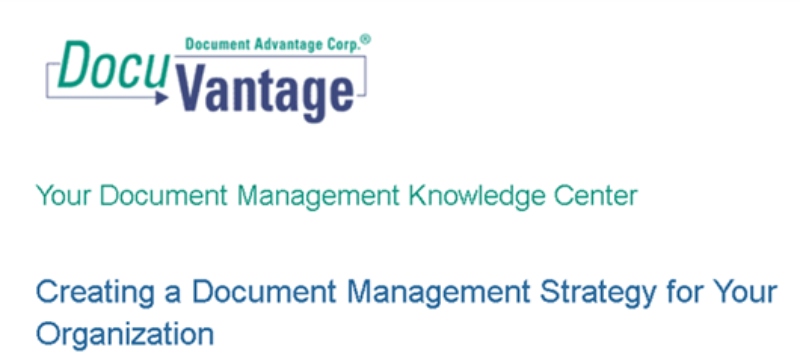
Once your initial strategy is outlined, you can add more details in a document management plan.
Create a document management plan
While your strategies are broad, your plan goes more into detail and takes into account all procedures and processes that work towards the goals of your strategy. To put it simply: Your document management plan puts your strategy into action.
If you need a starting point, you can take a look at the document management plan preparation guidelines as issued by the government of Qatar.
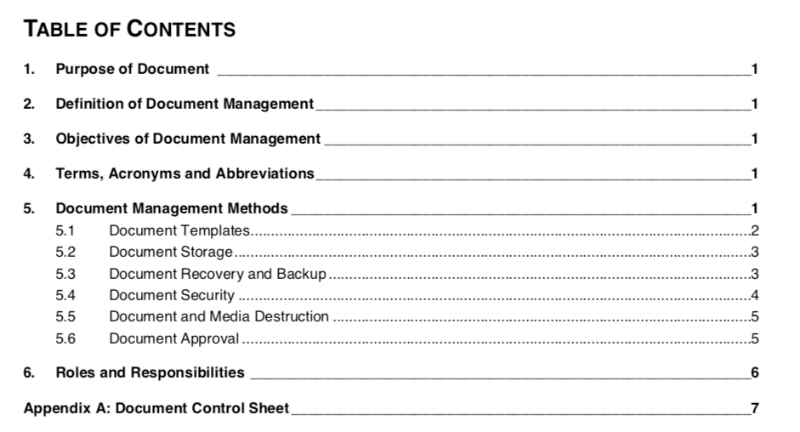
For instance, if cost savings are your main objective, a plan would outline each process that contributes to that goal. Your document management costs saving plan might include: How can you save labor costs by streamlining critical workflows, such as the review and approval processes?
Develop a document management policy
Why should your organization set up a document management policy?
After you have started your initial document management strategy and plan, it might be time to go one step further and develop document management policies.
In contrast to a strategy or a plan, a policy is an organizational guiding rule, that should be implemented in all strategies and processes.
To get some initial inspiration, examine the document management policy of the University of Bristol.
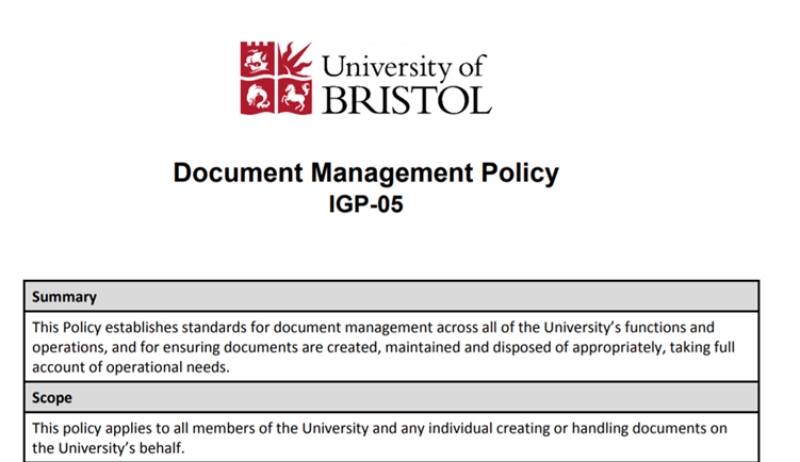
Once you have finished these three steps, it’s time to think about the right software solution to solve your problems.
How to Find the Best Document Management System for Your Needs
Now that your needs are clear and you know what you want to achieve with your document management system, it’s time to compare your favorite tools.
The next section will give you an overview of the most commonly used tools for small companies and big corporations. But before you can compare the tools on the market, you need to make sure you are certain about the following points:
What are the main pain points the solution should solve?
During the creation phase of your document management strategy, you probably have already thought about this. Make sure to put this point into the context of the abilities of the file management software that you consider purchasing.
For instance, it’s useless trying to save costs while looking at fancy software solutions that don’t fit your budget.
Which features are essential?
While outlining strategies, people often fall into the trap of trying to achieve everything at once. Deep down they may know it‘s not possible, but they may still have unrealistic expectations.
To avoid losing yourself in too many details and in order to generate realistic solutions, we suggest that you create a top 10 list of the most essential features your document management system should have.
Create a list of your favorite tools to compare them
Now you can shift your focus from the inside to the outside. After you are clear about your own needs, you can see what the market can offer.
In order to compare all different document management solutions, it’s advisable to make a spreadsheet and assess the tools according to your Top 10 feature list.
The most suitable file management software from your Top 10 list will become your new companion at the office.
Best Online Document Management Software
In this section, we introduce you to the most commonly used online document management software solutions.
Filestage – content review and approval
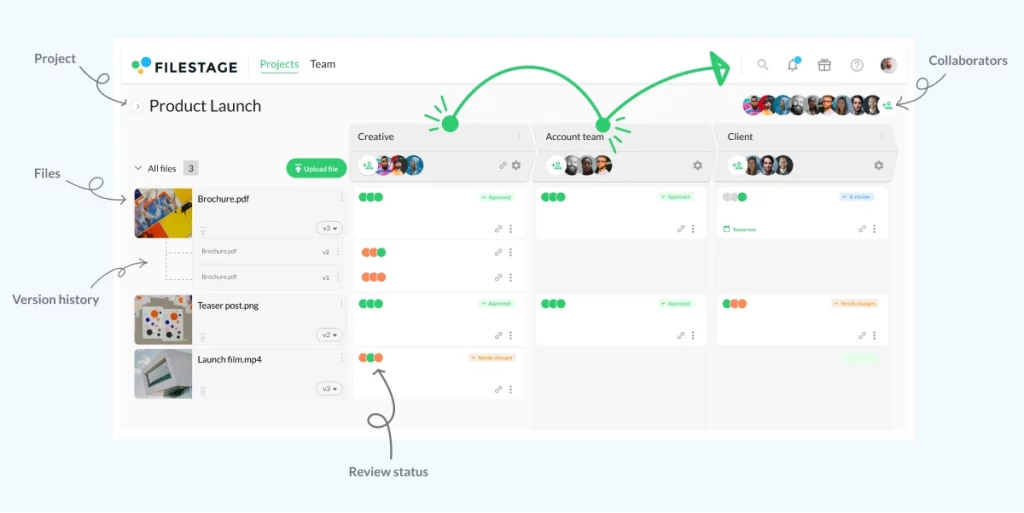
Filestage provides teams with a cloud-based platform to streamline the review and approval process for documents and other file types. The tool simplifies collaboration with colleagues and clients with customizable workflows, task automation and built-in versioning.
Filestage is easy to set up, learn and use. It also enables teams to run workflows in minutes. Moreover, the platform boosts the productivity of teams by reducing the effort and time spent in the approval process.
With Filestage, you can easily manage all of your approvals in a single place, and therefore always keep track of the status of your documents. That makes Filestage the perfect tool to organize your document feedback and approval process in a clear, easy and efficient way.
iManage – document and email management

iManage offers a cloud-based document and email management solution, Closing Folders, that mainly focuses on solutions tailored to law firms.
The software features collaboration tools that allow users to manage documents and collaborate either on their desktop or via a mobile-friendly interface optimized for smartphones and tablets. Emails and documents can smartly be combined into single project files.
You can get in touch with iManage to request a demo version or the price structure of Closing Folders.
Microsoft Sharepoint – intranet DMS
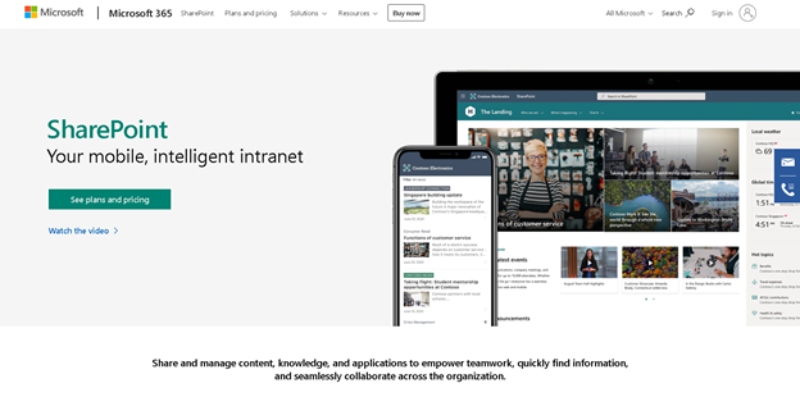
Microsoft Sharepoint belongs to one of the comprehensive collaboration tools on the market, the Microsoft Office Suite, and includes a comprehensive document management system.
Whether you need to simply create documents or share them with multiple stakeholders, Sharepoint offers a wide range of features and is customizable to your company’s needs.
This file management software comes in two different plans, which are catered to SMEs as well as large corporations. The basic plan starts as low as $5 per user on an annual basis.
Adobe Document Cloud – Adobe’s leading PDF tools
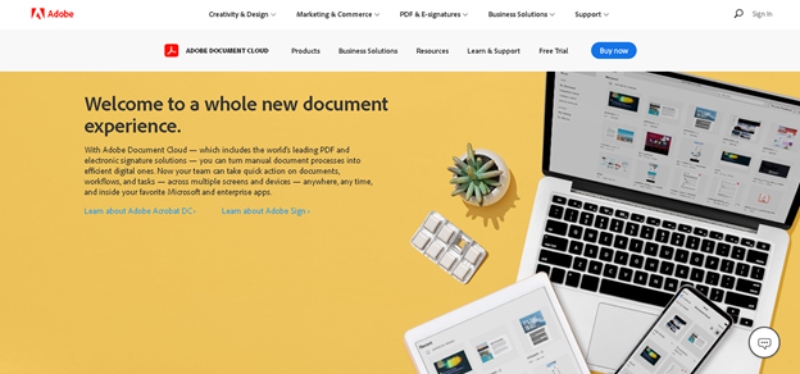
Everyone knows the famous Adobe Creative Cloud, which offers ground-breaking programs such as Photoshop or Illustrator. Adobe Document Cloud is a DMS that offers equally useful tools to manage all of your documents.
The Adobe Document Cloud consists of programs such as Adobe Acrobat DC to facilitate the document creation process through a collaborative interface. Additionally, Adobe Sign lets you easily create e-signatures and combines them with Adobe´s leading PDF tools.
The Adobe Document Cloud is available in different packages – for individuals, teams and enterprises.
OpenKM – 100% customizable DMS

OpenKM is an advanced document management system that ticks all the right boxes.
With the DMS, users can store, manage and track electronic documents and scans of paper documents, automate processes, collaborate on projects and set up workflows to review, approve and validate tasks.
With OpenKM’s development tool suite, the software even allows an IT department to become creative and to create a new app that caters 100% to the needs of your organization.
You can request a trial version and quote on the contact form of OpenKM.
Docuvita – versatile document management
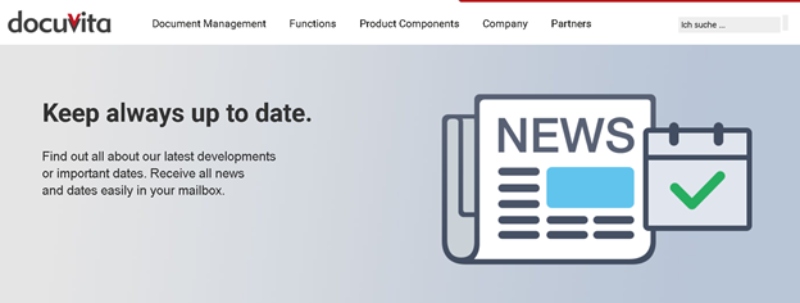
Docuvita is a versatile document manager that caters to a wide variety of document types.
Sensitive information such as personnel files are protected from unauthorized access by Docuvita, and accounting files can be combined with your company’s accounting software to create archives with legal conformity.
Files can be transferred from your ERP or CRM system to Docuvita to achieve the most efficient usage of all your systems.
In this file management software, you can also create multiple automated workflows so that you and your team can save time and concentrate on the things that matter most.
Get in touch with Docuvita to get a quote for your individual needs.
LogicalDOC – public cloud, on-premise or hybrid DMS
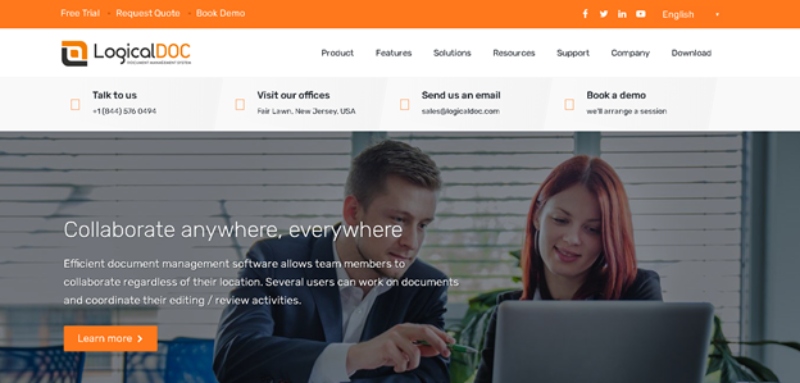
LogicalDOC is a DMS that is either cloud-based or on-premise so that your company can choose the most suitable solution for your current infrastructure.
The cloud service is suggested if your organization does not have the resources for a fully self-hosted system.
Furthermore, it’s possible to make use of a hybrid cloud document management system that combines a public and private cloud. A hybrid cloud serves as a perfect back-up solution: Your documents can always be recovered, even if your servers get damaged.
You can contact LogicalDoc for a free trial or pricing information.
Bitrix24 – project management and DMS

Bitrix24 is more than just an ordinary document management system.
Bitrix is a CRM system as well as a fully integrated project management tool that has many features to capitalize on your document management workflow.
From file sharing, storage, workload and scheduling functions to automation systems and chart creator – Bitrix24 offers a wide range of useful tools to boost collaboration and streamline processes.
Besides offering a free plan, Bitrix24 has five different subscription plans that can cater to your individual needs.
Filecamp – DAM and DMS
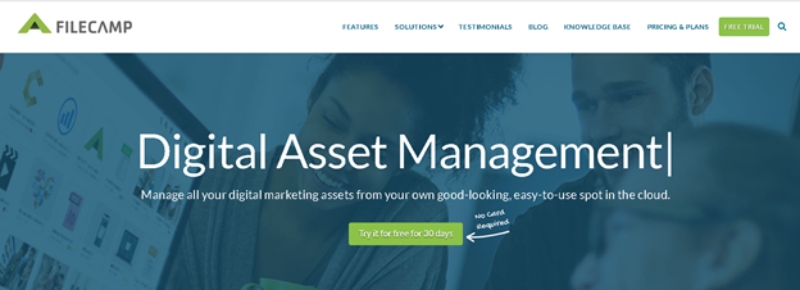
Filecamp is a fully fledged digital asset management (DAM) system that offers a huge variety of document management features.
Yourteam has access to a media library and brand guidelines as well as online proofing and approval solutions for streamlined collaboration.
Filecamp is an intuitive and easy-to-use platform that does not require intensive training. Additionally, the DAM system is available in three different subscription models.
Revv – special-purpose DMS
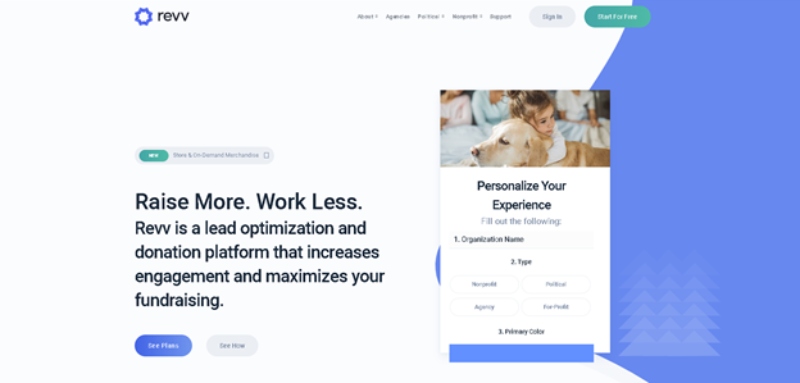
We are going to end this section with Revv, a specialized platform for lead donation and increasing user engagement and fundraising.
The political compliance and reporting tools of Revv are completely customizable and can produce automated report schedules. Special features, such as one-click donations or forms, petitions and surveys, help non-profit organizations streamline their workflows and free up scarce resources.
Moreover, this file management software is equipped with sales tools that help organizations upsell their services and offers.
Revv Basic is free, while Revv Pro is available at $49 per month. Enterprises can also request a customized quotation.
Conclusion
When managing your organization, it’s important to improve wherever possible. At first sight, document management may seem like a secondary activity that does not warrant a lot of attention.
However, as our examples have shown, a company implementing an efficient document management approach will save valuable time, resources and money, in addition to producing higher quality assets. In order to make the necessary changes, it’s important to get the support of the right stakeholders throughout the organization.
We hope this article raises awareness and support within your company to further streamline time-consuming processes.

